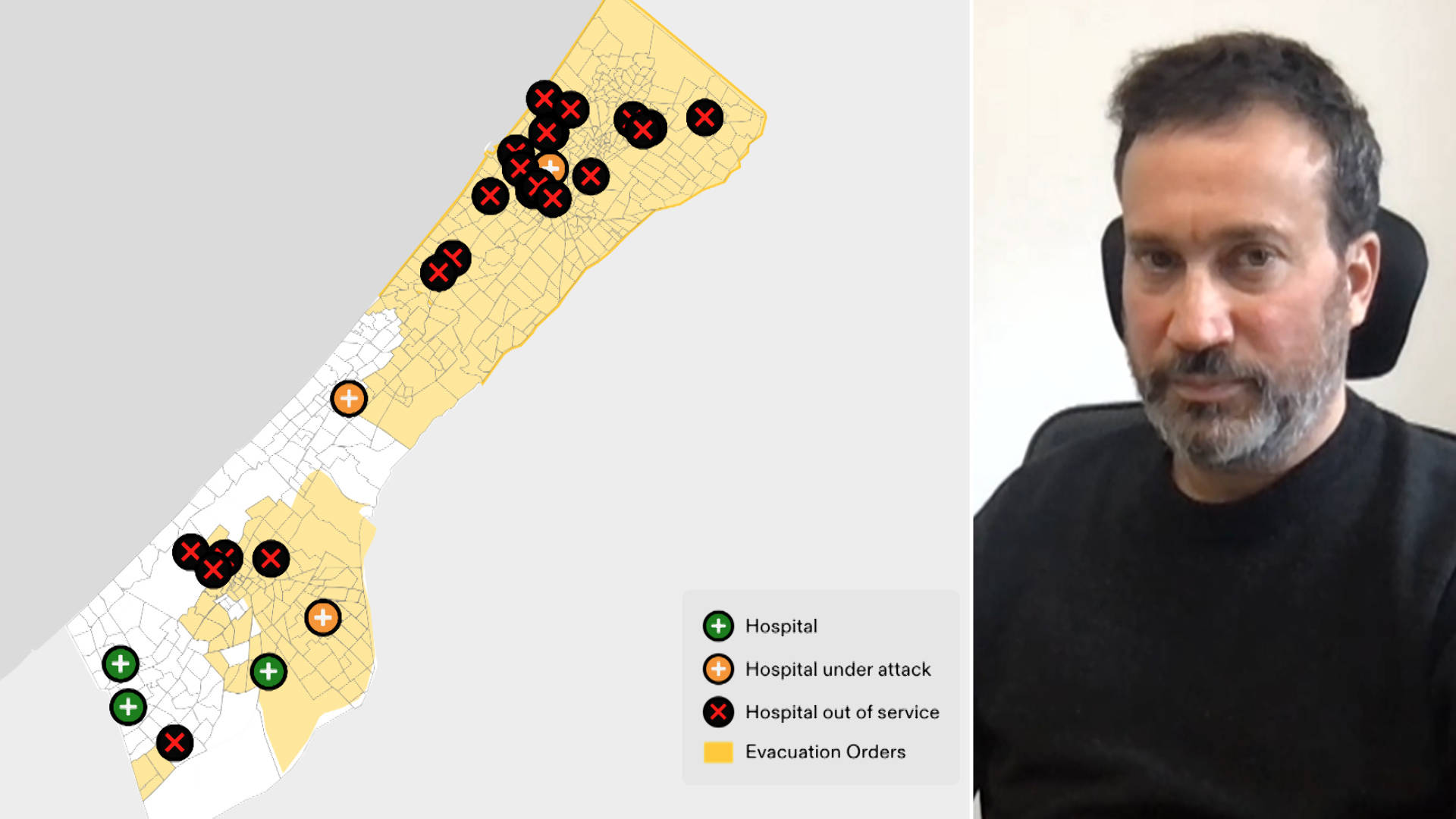This is a rush transcript. Copy may not be in its final form.
AMY GOODMAN: This is Democracy Now!, democracynow.org, The War and Peace Report. I’m Amy Goodman, with Nermeen Shaikh.
NERMEEN SHAIKH: We look now at a new report published by the research group Forensic Architecture, which counters Israel’s argument at the International Court of Justice that it followed humanitarian policies to safeguard civilian life in Gaza. South Africa argued in January before the ICJ that Israel was guilty of genocide during its war on Gaza. The report argues that what Israel says are humanitarian evacuations in Gaza actually amount to the forced displacement of Palestinians, which is a war crime.
AMY GOODMAN: For more, we’re joined in London by Eyal Weizman, a British Israeli architect born in Haifa. He’s founder and director of Forensic Architecture, a professor of spatial and visual cultures at Goldsmiths College at the University of London. He’s the author of several books, including Hollow Land: Israel’s Architecture of Occupation and The Least of All Possible Evils: A Short History of Humanitarian Violence. He’s also a member of the Technology Advisory Board of the International Criminal Court and of the Center for Investigative Journalism.
Eyal, welcome to Democracy Now! As we come to air right now, the United States has presented a resolution to the U.N. Security Council for a temporary ceasefire. I’m wondering if you could respond to that and Netanyahu only speaking with Republicans, behind closed doors — now he might be addressing a joint session of Congress, if the House speaker decides to invite him — saying that Rafah invasion will happen.
EYAL WEIZMAN: Yeah. If a Rafah invasion will happen, we will see the humanitarian disaster, the man-made humanitarian disaster imposed on Gaza, just aggravated to levels that we haven’t yet experienced. In Rafah, we have a huge part of the Palestinian people evacuated to living in inhumane conditions where there are famine and lack of basic humanitarian provisions, in something that is called a “safe zone.” And I think that it’s important to understand that there is no safe place in Gaza. Although Israel is designating part of the Strip as so-called safe areas and ordering the population to evacuate to them, it continuously imposes on these areas conditions that amount to unlivable conditions and in continuation of its genocidal policies.
So, what we need to — my comment to that is, rather than allowing any or entertaining any specific plans and provisions, you know, that the U.S. is discussing now with the Israelis about allowing them to attack Rafah under certain conditions, we need to see immediate ceasefire across the board in all places of Gaza, in order to allow for the rebuilding of the Strip, in order to allow for humanitarian provision to reach each and every Palestinian in the north and in the south.
NERMEEN SHAIKH: Well, Eyal Weizman, the proposal that the U.S. has put forth — this is before we turn to your report. The proposal that the U.S. has put forth for a temporary ceasefire is reportedly for the release of Israeli hostages and allowing more humanitarian aid into Gaza. You wrote in a piece — I want to ask you about a piece you wrote for the London Review of Books in November in which you document — the piece is headlined “Exchange Rate,” where you document the change in Israel policy with respect to its hostages. So, if you could talk about the way that that’s played out? You wrote the piece in November. If you could talk about the way that’s played out, and how you think that might affect what happens now, going forward, with respect to the hundred or so hostages who remain, who are reportedly still alive?
EYAL WEIZMAN: I think that what you see in all negotiations around the captives and the Palestinian prisoners sitting in Israeli prisons, some of them on administrative detentions without charge, thousands of them, is that Israel has been creating and enlarging its bank of prisoners in order to create — in order to allow it to change the exchange rate. The title of that piece in the LRB was “Exchange Rate,” and it was looking at the history of Palestinian resistance to Israeli occupation through the capture of captives, from — really, from the famous airplane hijacks of the ’70s all the way to the present, the way in which Palestinians forced Israel into — the only way that Palestinians could actually affect and release their prisoners is through capturing Israeli captives. Over the years, the exchange rate has changed favorably to the Palestinians. And what you’re seeing is that Israel is now arresting people in order — Palestinians, again, and holding them in administrative detention, in order to beef up its bank of captives.
More than that, you could see that in the reports on the negotiation, the fate of those people that have been purportedly evacuated into safe areas is being brought into the equation. One way of thinking about it is to say, of course, Hamas or Palestinian factions in Gaza are holding over 100 Israeli captives, and Israel is holding close to 2 million Palestinian captives and bargaining for their return home in exchange for its prisoners. And that is obviously patently illegal, according to international law. And the fact that even that is being brought into the negotiation testifies that that was the intent of holding them away from their home as a bargaining chip towards that. So, you have an exchange rate now that is 200 million Palestinians displaced — sorry, 2 million Palestinians displaced, 100 Israeli captives, and this is really where the negotiations are going.
NERMEEN SHAIKH: Eyal Weizman, let’s turn to your report, the Forensic Architecture report, which is headlined “Humanitarian Violence in Gaza.” If you could begin just by explaining — the two words don’t normally come together, “humanitarian” and “violence.”
EYAL WEIZMAN: Right.
NERMEEN SHAIKH: If you could explain what you mean by that? Of course, you’ve also written a book on this. And then lay out the three phases of mass displacement that you document in the report.
EYAL WEIZMAN: Yeah. So, you know, we think about humanitarian principles — and part of them is international humanitarian law, so-called the laws of war — as being there to protect civilians. But a certain manipulation of international humanitarian law allows you to have operational advantage, or, in this case, advantage in negotiation over the captives in this particular way. So, there is a principle, an accepted principle, in international — in humanitarianism that if you want to evacuate a population into a safe zone, that safe zone needs to have several conditions. There needs to be proper medical care. There needs to be proper food and housing in these areas. Israel has evacuated — ordered the evacuation of Palestinians from within Gaza and from the north to the south into areas that were repeatedly under attack, into areas with no housing, no medical care, and now that we see no food is being provided in it, or very little, or not sufficient levels of aid within that. So, that is, firstly, you know, the kind of the principle of using a humanitarian principle that is purportedly used in order to save, in order to treat civilians and take them out of harm’s way, in order to achieve Israel’s operational objectives in this attack on Gaza, and that is to exercise pain on the civilian population to generate levels of destruction and harm that would deter Palestinians from ongoing resistance to the Israeli occupation.
And it’s becoming more and more clear that the harm, that the levels of destruction that we’re seeing, that the level of displacement that we’re seeing, are not the byproduct and not the collateral effects of this conflict, but really the only thing that Israel has achieved during that war. It hasn’t achieved any of its tactical aims. It hasn’t dismantled Hamas as an operative force. It hasn’t captured the Hamas leadership. It hasn’t freed hostages, except of in very rare situations. What it has done is create an equation in which the civilian population is being put in harm’s way in order to bargain against their return back to the north, to north of Gaza, in order to effectively achieve what tactically Israel has not achieved.
So, in relation to the stages, a week or so after the October 7th attack, Israel has given the entirety of the north of Gaza an evacuation order. They were ordered to leave the north of Gaza, home to over a million Palestinians, the center of Palestinian political, cultural life, was actually ordered to cross Wadi Gaza, which divides, according to them, Gaza into north and south. That was the first stage. And after the ceasefire, the temporary ceasefire in which some prisoner exchange was happening at the beginning of December, what Israel has done is releasing an interactive map online, dividing Gaza into kind of a gerrymandered 623 zones. It was very difficult, with people that we spoke to in Gaza, to understand whether they are in zone number 546 or 547. The map was extremely confusing. It was released online at a time of very frequent internet and power cuts, or it was communicated via leaflets that were unevenly distributed. It was an incredibly confusing system that led to the ongoing displacement of Palestinians from one zone to the other. So, when they were — after they were ordered to all move into southern Gaza, from different parts in the southern part of Gaza, they were ordered to go into different places.
And what the report is showing is the systematic and ongoing use of these evacuation orders were meant to achieve that population displacement and that people were continuously being put in harm’s way. The routes, the so-called safe routes, along which Palestinians were ordered to evacuate were attacked. Areas where they went to had no provisions and very often were attacked themselves. So, we cannot see that humanitarian policy, so-called humanitarian policy, of the Israeli forces — and the argument that the Israelis put forward in The Hague that, you know, they are not in violation of the Genocide Convention because they apply humanitarian principle, but we cannot see it as anything else but part of the genocidal campaign that is actually inflicted on Palestinians in Gaza.
AMY GOODMAN: And now, of course, if Netanyahu does succeed in a full-scale ground invasion of Rafah, they will go back to all these places they were forced to flee. And they talk about, “No worries, Palestinian civilians will be protected in these humanitarian zones.” Eyal Weizman, if you could respond to that? And also, just for people to understand, your organization is so unusual, and it also operates in several different countries, you yourself born in Haifa. If you could explain how you do what you do? We are also showing a series of maps, where you show the stages, one, two, three. You’ve done so many different investigations, from who killed Shireen Abu Akleh, the great Al Jazeera Arabic reporter — when Israel was saying caught in crossfire, you proved the opposite: She was killed by an Israeli sniper — among other things. Can you talk about what Forensic Architecture does, and what you, as an Israeli British architect, are doing in this kind of analysis — an architect?
EYAL WEIZMAN: Yeah, thank you for asking that. Of course, the nature of the Israeli occupation in Gaza and the West Bank, and throughout Palestine complete, makes use of architecture as part of the violence applied on Palestinians. So, starting from the location of settlements on hilltops in a way that divide the Occupied Territories, surveys it, bisect Palestinian-built fabric, the design of roads, the provisional infrastructure, you could say that settler colonialism is architecturally enacted.
In Gaza, obviously, we had settlements in Gaza up until 2005, when they were evacuated, but after that, the Gaza envelope is a system of civilian and military infrastructure that included a number of fences and earth berms and military facilities, as well as kibbutzim and moshavim. These are agrarian settlements that are part of what Israel always called its regional defense.
Of course, all that system was attacked on October 7th. So you could see how architecture is mobilized as part of the system of control and occupation of Palestinians. You could see why Palestinians would attack that system of infrastructure — and this is without commending and, of course, not supporting the killing and abduction of civilians.
But I think that architecture is a key part of that, of understanding the conflict, the long history of Israel’s settler colonization, and also understanding what is happening in Gaza now. It is happening in urban environment. And one has to understand what this urban environment, that has been created over the years of — you know, since, really, the Gaza Strip was created as a historical anomaly in 1948, when it was carved out as a kind of concentration area for refugees, becoming one of the densest parts of the world, most densely inhabited part of the world. How do you control population centers? And a lot of thinking was done from the Israeli side in terms of thinking about the control of Palestinians as an urban problem.
And what we see now happening in Gaza is the shaping of Gaza for, you know, the day after. Would it come now? Would it come in weeks, in months? We do not know. But what we see is Israel actually shaping the built fabric, destroying all homes and agricultural areas in a huge buffer zone along the border, creating east-west routes, not only the famous one that we know, around Deir al-Balah, but all throughout that very long and thin strip of territory, the Gaza Strip, we see it being truncated, almost cut like salami, with routes and military infrastructure that would be there in order to isolate and divide different parts of the Gaza Strip, if resistance continues, from the Palestinian parts.
And so, architecture — if architecture is really the means by which Israel exercises control, we, architects, and the organization that I run, Forensic Architecture, is — you know, has many architects working with us, but also open-source investigators, journalists, lawyers, etc. — we are monitoring things from a cartographic, spatial and architectural perspective. We work very closely, and we have a partner organization in Ramallah, the Al-Haq Forensic Architecture Unit, because we understand that working in Palestine, like working anywhere else in the world — Forensic Architecture has also got offices in Mexico, in Bogotá; now we’re starting one in Istanbul, in Athens, in many other places in the world. But understanding the lived reality, understanding the way that architecture is used as an oppressive mechanism requires also the lived experience — understanding the lived experience of people there. And therefore, when we’ve done that report that you mentioned, we’ve been in touch with — we’ve been in touch with Palestinians on the ground, we’ve been in touch with medical professionals, with doctors, in understanding the conditions in the so-called safe zones. And as I say, there are no safe areas in Gaza.
We’ve tried to understand the spatial logic of that campaign. And we could see that one of the main strategic tools for Israel to control and afflict that pain on Gaza is through the evacuation orders, and that they have been spatially designed — initially, again, dividing north Gaza from south Gaza, and then dividing it into 600 Tetris parts, if you like, in which, you know, you would get very a confusing order in which your number would come up, and you would be told to go from that number zone into another number zone. Do you get this message? Do you understand it? And also, on the way, you’d be attacked. And the zone in which you’re being evacuated to is itself unsafe and unlivable.
So, here what we see is the abuse of humanitarian principles to further Israeli genocidal campaign. And this is why we call that report “Humanitarian Violence.” We need to be very, very wary when we are speaking about humanitarian principles in war, because very often militaries — not only the Israeli militaries, but, you know, Western, Northern, global — militaries from the Global North, when they engage in urban warfare in parts of the Global South, they are applying humanitarian principles — they’re playing international law in a particular way that does not contain violence, that actually amplifies it.
I’ll give you another example for that: warnings. You know, you could think that to warn a population is actually something that could be very, very helpful. It could save lives. But, actually, the aims of these warnings, or what is implied in them — and sometimes explicitly mentioned — is that if you do not heed the warning, you would be considered potentially part of the armed resistance in a particular area. That means you get redesignated from a protected civilian to a nonprotected either voluntary human shield or part of a resistance, if you do not heed the warning. So, in a sense, with one legal tool, you created the redesignation of a big part of the population, and you basically let the blood in that way. So, humanitarianism, when it — those principles, when they’re using in such a brutal campaign, it could be actually part of the problem, rather than something that is moderating and defending civilians.
NERMEEN SHAIKH: Eyal Weizman, if we could talk a little bit more about that? The scale, just to point out, just to give us a sense of the scale of the crisis of mass expulsions, at the moment, almost 70% of the total area of the Gaza Strip has been issued evacuation orders. If you could say, very quickly, in terms of the International Court of Justice ruling, what does your report suggest about the defense that Israel presented?
EYAL WEIZMAN: Yeah, that the defense is completely inapplicable. We will show how — and we have shown how — Israeli military, the occupation forces, when they maneuver through — if you look at things in relation to each other, if you look at military maneuver, you look at areas that have been bombed, as we have, through speaking to people, through analyzing videos, through looking at satellite imagery, we have a good understanding, we have a good map of what are the areas that have been bombed. Overlay that with the so-called safe zones, overlay them with Israeli military maneuver, and what you see is, A, civilians are being evacuated into areas that have been bombed, that have no facilities, and are continuously bombing — they are still being bombed as Israel has ordered civilians into them. And you see, in some cases, Israeli military maneuver, Israeli invasion into the area it itself designated as safe zones.
So, in a sense, you see those categories operating in relation to each other as part of an overall strategy, rather than you’re seeing humanitarian principle pushing against military violence and moderating it. You see it has become one of the tools in the Israeli campaign toolbox to generate that level of destruction in Gaza. So, you know, you’re speaking about 70% of the area is being displaced. And the proportion —
AMY GOODMAN: Eyal, we have 10 seconds.
EYAL WEIZMAN: The proportion of people displaced is much higher, and the proportion of civilian infrastructure destroyed is almost complete. So, look at those things together and understand the militarization of humanitarian principles.
AMY GOODMAN: Eyal Weizman, we clearly have so much to talk about. We’d like to ask you to stay, and we’ll post Part 2 online at democracynow.org. Eyal Weizman is a British Israeli architect, founder and director of Forensic Architecture. We’ll link to the new report, “Humanitarian Violence: Israel’s Abuse of Preventive Measures in Its 2023-2024 Genocidal Military Campaign in the Occupied Gaza Strip.”











Post comments (0)